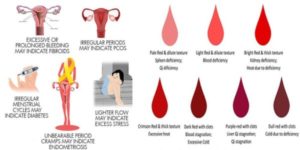Abnormal (Dysfunctional) Uterine Bleeding
- Abnormal uterine bleeding (AUB) is irregular menstrual bleeding (usually heavy, prolonged, or frequent); it is a diagnosis of exclusion after establishment of normal anatomy and the absence of other medical illnesses and pregnancy.
- May be acute or chronic (occurring >6 months)
- The International Federation of Gynecology and Obstetrics (FIGO) revised the terminology system and now uses AUB rather than dysfunctional uterine bleeding (DUB).
- Commonly associated with anovulation


Bleeding that differs in quantity or timing from a woman’s usual menstrual flow is considered AUB. For instance, a woman may bleed more heavily during one period and more lightly the next, spot between periods, or have a shorter or longer interval between periods. Some women may bleed for less than 2 days or more than 7 days.
Women who bleed heavily on a regular basis most likely have an ovulatoiy cycle problem rather than an anovulatory cycle one. Because these women are usually ovulating, they tend to experience premenstrual symptoms and cramping.
So what causes AUB? The most common causes are pregnancy and pregnancy-related conditions. The list of other causes is extensive and includes infections of the genital tract, fibroids, malignancies, medications, blood dyscrasias, and disorders of the thyroid gland, adrenal gland, kidney, or liver. Even stress can cause AUB.
Sorting out risk factors
Any woman is at risk for AUB, while those who are younger than 20 or older than 40 are at higher risk for DUB. That’s because women in these age-groups, who are at die beginning or end of their reproductive lives, are most likely to experience hormonal imbalance and anovulation.
Women at highest risk for DUB include those who:
* are overweight, because hormones involved in ovulation aren’t readily available from fat stores
* exercise excessively, because they don’t have enough body fat to maintain a menstrual cycle
* are under a great deal of stress
* have polycystic ovarian syndrome.

How is abnormal uterine bleeding diagnosed?

The tests your doctor orders may depend on your age. If you could be pregnant, your doctor may order a pregnancy test. If your bleeding is heavy, in addition to other tests, your doctor may want to check your blood count to make sure you don’t have a low blood count from the blood loss. This could lead to iron deficiency and anemia.
An ultrasound exam of your pelvic area shows both the uterus and the ovaries. It may also show the cause of your bleeding.
Your doctor may want to do an endometrial biopsy. This is a test of the uterine lining. It’s done by putting a thin plastic tube (called a catheter) into your uterus. Your doctor will use the catheter to remove a tiny piece of the uterine lining. He or she will send that lining to the lab for testing. The test will show if you have cancer or a change in the cells. A biopsy can be done in the doctor’s office and causes only mild pain.
Another test is a hysteroscopy. A thin tube with a tiny camera in it is put into your uterus. The camera lets your doctor see the inside of your uterus. If anything abnormal shows up, your doctor can get a biopsy.
